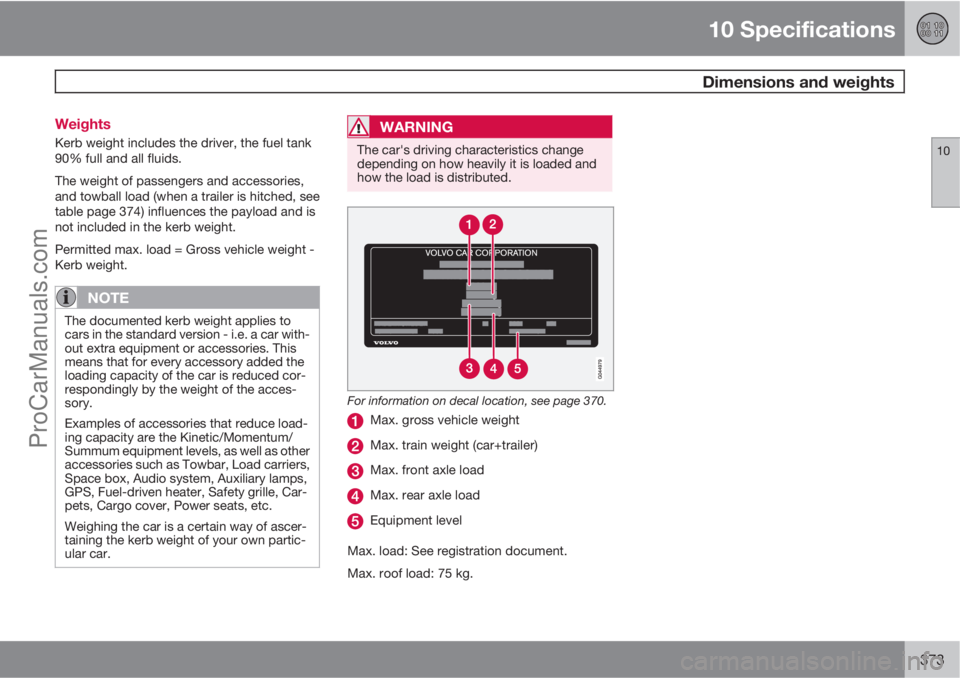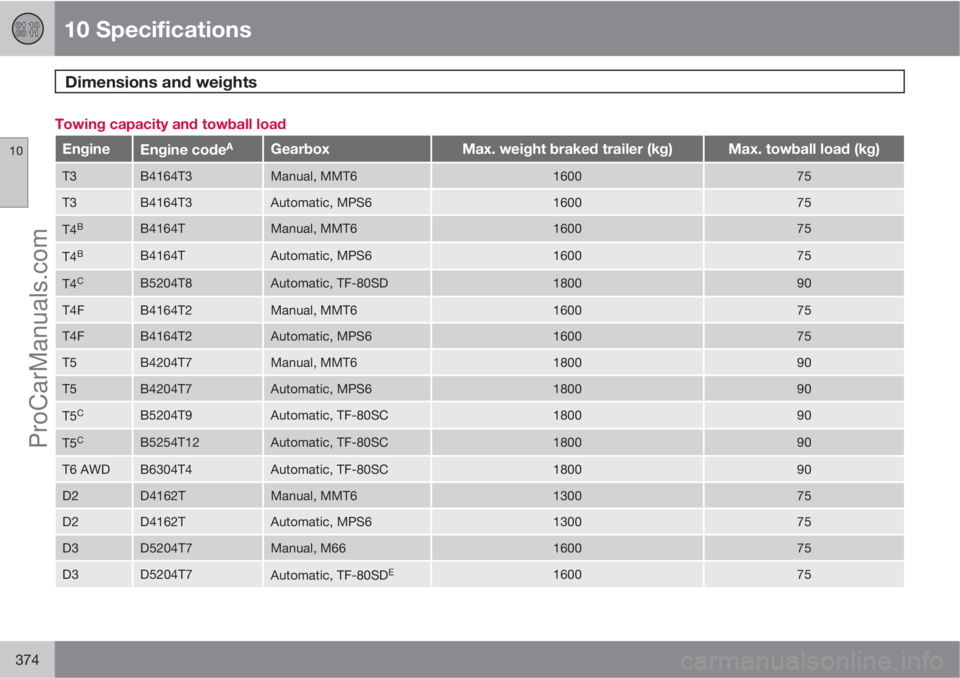2013 VOLVO V60 load capacity
[x] Cancel search: load capacityPage 157 of 422

04 Driver support
Adaptive cruise control*
04
* Option/accessory, for more information, see Introduction.155
WARNING
Adaptive cruise control is not a collision
avoidance system. The driver must inter-
vene if the system does not detect a vehicle
in front.
The adaptive cruise control does not brake
for humans or animals, and not for small
vehicles such as bicycles and motorcycles.
Nor for oncoming, slow or stationary vehi-
cles and objects.
Do not use the adaptive cruise control, for
example, in city traffic, in dense traffic, at
junctions, on slippery surfaces, with a lot of
water or slush on the road, in heavy rain/
snow, in poor visibility, on winding roads or
on slip roads.
The distance to the vehicle ahead is mainly
measured by a radar sensor. Cruise control
regulates the speed with acceleration and
braking. It is normal for the brakes to emit a low
sound when they are being used by the Adap-
tive cruise control.
WARNING
The brake pedal moves when the cruise
control brakes. Do not rest your foot under
the brake pedal as it could become trapped.
The adaptive cruise control aims to follow the
vehicle ahead in the same lane at a time interval
set by the driver. If the radar sensor cannot see
any vehicle in front then the car will instead
maintain the cruise control's set speed. This
also happens if the speed of the vehicle in front
exceeds the cruise control's set speed.
The adaptive cruise control aims to control the
speed in a smooth way. In situations that
demand sudden braking the driver must brake
himself/herself. This applies with large differ-
ences in speed, or if the vehicle in front brakes
heavily. Due to limitations in the radar sensor,
braking may come unexpectedly or not at all,
see page 160.
The adaptive cruise control can be activated to
follow another vehicle at speeds from
30 km/h
2 up to 200 km/h. If the speed falls
below 30 km/h or if the engine speed becomes
too low, the cruise control is set in standby
mode at which automatic braking ceases - the
driver must then take over himself/herself to
maintain a safe distance to the vehicle ahead.
Warning lamp - braking by driver
required
Adaptive cruise control has a braking capacity
that is equivalent to more than 40% of the car's
braking capacity.If the car needs to be braked more heavily than
cruise control capacity and the driver does not
brake, then the cruise control uses the collision
warning system's warning lamp and warning
sound (see page 173) to alert the driver that
immediate intervention is required.
NOTE
The warning lamp may be difficult to notice
in strong sunlight or when sunglasses are
being worn.
WARNING
Cruise control only warns of vehicles
detected by the radar sensor. Consequently
there may be no warning or it may be sub-
ject to a delay. Do not wait for a warning but
brake when it is necessary.
Steep roads and/or heavy loadBear in mind that the adaptive cruise control is
primarily intended for use when driving on level
road surfaces. It may have difficultly in keeping
the correct distance from the vehicle ahead
when driving on steep roads, with a heavy load
or with a trailer - in which case, be extra atten-
tive and ready to slow down.
2Queue Assistant (in cars with automatic gearbox) can operate in the range of 0-200 km/h, see page 159.
ProCarManuals.com
Page 171 of 422

04 Driver support
City Safety™
04
169
If the difference in speed between the vehicles
is greater than 15 km/h then City Safety™ may
not prevent the collision on its own. To obtain
full brake force, the driver must depress the
brake pedal. This could then make it possible
to prevent a collision, even at speed differen-
ces above 15 km/h.
When the function is activated and brakes, the
instrument panel display shows a message to
the effect that the function is/has been active.
NOTE
The brake lights come on when City
Safety™ brakes the car.
Operation
NOTE
The City Safety™ function is always ena-
bled after the engine has been started via
key position I and II (see page 78 on key
positions).
On and OffIn certain situations, it may advisable to disable
City Safety™, e.g. where leafy branches could
sweep over the bonnet and/or windscreen.
After starting the engine City Safety™ can be
deactivated as follows:
•Using MY CAR on the centre console dis-
play screen with its menu system, search
and locate Settings
Car settings
Driver support systemsCity Safety.
Select the
Off option. For more information
on the menu system MY CAR, see
page 202.
However, the function will be enabled the
next time the engine is started, regardless
of whether the system was enabled or dis-
abled when the engine was switched off.
WARNING
The laser sensor also transmits laser light
when City Safety™ is disabled manually.
To enable City Safety™ again:
•Follow the same procedure as for disa-
bling, but select the On option.
Limitations
The sensor in City Safety™ is designed to
detect cars and other large vehicles in front of
the car irrespective of whether it is day or night.
However, the sensor has limitations and has
poorer functionality - or none at all - in e.g.
heavy snowfall or rain, dense fog, dust storms
or snow flurries. Mist, dirt, ice or snow on the
windscreen may disrupt the function.Low-hanging objects, e.g. a flag/pennant for
projecting load, or accessories such as auxili-
ary lamps and bull bars that are higher than the
bonnet limit the function.
The laser light from the sensor in City
Safety™ measures how the light is reflected.
The sensor cannot detect objects with low
reflection capacity. The rear sections of the
vehicle generally reflect the light sufficiently
thanks to the number plate and rear light reflec-
tors.
On slippery road surfaces the braking distance
is extended, which may reduce the capacity of
City Safety™ to avoid a collision. In such sit-
uations the ABS and DSTC systems will pro-
vide best possible braking force with main-
tained stability.
When your own car is reversing, City Safety™
is temporarily deactivated.
City Safety™ is not activated at low speeds -
under 4 km/h, which is why the system does
not intervene in situations where a vehicle in
front is being approached very slowly, e.g.
when parking.
Driver commands are always prioritised, which
is why City Safety™ does not intervene in sit-
uations where the driver is steering or acceler-
ating in a clear manner, even if a collision is
unavoidable.
ProCarManuals.com
Page 315 of 422

08 Wheels and tyres
General
08
313
16Rim diameter in
inches
50Off-set in mm (dis-
tance from wheel
centre to wheel con-
tact surface against
the hub)
Tyre dimensionsThe dimensions are stated on all car tyres.
Example of designation: 215/55R16 97W.
215Tyre width (mm)
55Ratio between tyre wall height and
tyre width (%)
RRadial ply
16Rim diameter in inches (")
97Codes for the maximum permitted
tyre load, tyre load index (LI)
WSpeed rating for maximum permitted
speed, speed rating (SS). (In this case
270 km/h).
Load indexEach tyre has a certain capacity to carry a load,
a load index (LI). The car's weight determines
the load capacity required of the tyres. Mini-mum permitted index is specified in the table,
see page 388.
Speed ratingsEach tyre can withstand a certain maximum
speed, a speed rating (Speed Symbol; SS).
Tyre speed class must at least correspond with
the car's top speed. Minimum permitted speed
rating is specified in the table, see page 388.
The only exception to these conditions is win-
ter tyres (both those with metal studs and those
without), where a lower speed rating may be
used. If such a tyre is chosen, the car must not
be driven faster than the speed rating of the
tyre (for example, class Q can be driven at a
maximum of 160 km/h).
Traffic regulations determine how fast a car
can be driven, not the speed rating of the tyres.
NOTE
It is the maximum permitted speed that is
stated in the table.
Q160 km/h (used only on winter tyres)
T190 km/h
H210 km/h
V240 km/h
W270 km/h
Y300 km/h
WARNING
The car must be fitted with tyres which have
the same or a higher load index (LI) and
speed rating (SS) than specified. If a tyre
with too low a load index or speed rating is
used, it may overheat.
ProCarManuals.com
Page 375 of 422

10 Specifications
Dimensions and weights
10
373 Weights
Kerb weight includes the driver, the fuel tank
90% full and all fluids.
The weight of passengers and accessories,
and towball load (when a trailer is hitched, see
table page 374) influences the payload and is
not included in the kerb weight.
Permitted max. load = Gross vehicle weight -
Kerb weight.
NOTE
The documented kerb weight applies to
cars in the standard version - i.e. a car with-
out extra equipment or accessories. This
means that for every accessory added the
loading capacity of the car is reduced cor-
respondingly by the weight of the acces-
sory.
Examples of accessories that reduce load-
ing capacity are the Kinetic/Momentum/
Summum equipment levels, as well as other
accessories such as Towbar, Load carriers,
Space box, Audio system, Auxiliary lamps,
GPS, Fuel-driven heater, Safety grille, Car-
pets, Cargo cover, Power seats, etc.
Weighing the car is a certain way of ascer-
taining the kerb weight of your own partic-
ular car.
WARNING
The car's driving characteristics change
depending on how heavily it is loaded and
how the load is distributed.
For information on decal location, see page 370.
Max. gross vehicle weight
Max. train weight (car+trailer)
Max. front axle load
Max. rear axle load
Equipment level
Max. load: See registration document.
Max. roof load: 75 kg.
ProCarManuals.com
Page 376 of 422

10 Specifications
Dimensions and weights
10
374
Towing capacity and towball load
EngineEngine codeAGearboxMax. weight braked trailer (kg)Max. towball load (kg)
T3B4164T3Manual, MMT6160075
T3B4164T3Automatic, MPS6160075
T4BB4164TManual, MMT6160075
T4BB4164TAutomatic, MPS6160075
T4CB5204T8Automatic, TF-80SD180090
T4FB4164T2Manual, MMT6160075
T4FB4164T2Automatic, MPS6160075
T5B4204T7Manual, MMT6180090
T5B4204T7Automatic, MPS6180090
T5CB5204T9Automatic, TF-80SC180090
T5CB5254T12Automatic, TF-80SC180090
T6 AWDB6304T4Automatic, TF-80SC180090
D2D4162TManual, MMT6130075
D2D4162TAutomatic, MPS6130075
D3D5204T7Manual, M66160075
D3D5204T7Automatic, TF-80SDE160075
ProCarManuals.com
Page 412 of 422

11 Alphabetical Index
11
410
Cleaning
automatic car washes......................... 361
car wash............................................. 361
rims..................................................... 362
seatbelts............................................. 364
upholstery........................................... 363
Clean Zone Interior Package (CZIP)........ 211
Climate control........................................ 210
general................................................ 210
sensors............................................... 210
Clock, setting............................................. 75
CO
2 emissions ........................................ 384
Collision..................................................... 30
Collision warning.............................173, 174
Collision warning system
radar sensor........................ 160, 168, 173
Collision Warning with Auto Brake*......... 173
Colour code, paint................................... 365
Combined instrument panel..............71, 200
Comfort inside the passenger compart-
ment......................................................... 227
Compass................................................. 106
calibration........................................... 106
Condensation in headlamps.................... 361controls
centre console ................................... 235
Controls
centre console.................................... 202
Controls, lights........................................... 86
Control symbols......................................... 72
Cooling system........................................ 284
Corner Traction Control .......................... 146
Crash, see Collision................................... 30
Cruise control.......................................... 152
CZIP (Clear Zone Interior Package)......... 211
D
DAB Radio............................................... 249
Deadlock
deactivation.......................................... 60
temporary deactivation......................... 61
Deadlocks.................................................. 60
Defroster.................................................. 217
Diesel.......................................................289
Diesel particle filter..................................290
Dipstick, electronic.................................. 331Direction indicators.................................... 92
Disengaging the gear selector inhibitor. . . 124
Display lighting.......................................... 86
Distance Warning....................................165
Dolby Surround Pro Logic II.................... 234
Door mirrors............................................. 103
Driveable punctured tyres........................ 320
Driver Alert Control.................................. 182
Driver Alert System.................................. 181
Driving...................................................... 284
cooling system.................................... 284
with the tailgate open.........................285
with trailer........................................... 298
Driving in water........................................ 284
Driving with a trailer
towball load........................................ 373
towing capacity..................................373
DSTC, see also Stability control system.. 147
DVD ......................................................... 252
E
ECC, electronic climate control...............213
Economical driving.................................. 284
ProCarManuals.com